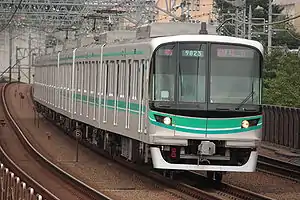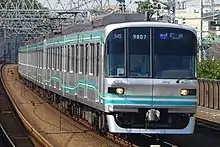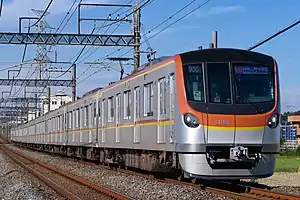Tokyo Metro 9000 series
The Tokyo Metro 9000 series (東京メトロ9000系, Tōkyō Metoro 9000-kei) is an electric multiple unit (EMU) train type operated by the Tokyo subway operator Tokyo Metro on the Tokyo Metro Namboku Line in Tokyo, Japan, since 1991.
| Tokyo Metro 9000 series | |
|---|---|
 5th-batch set 23 on the Tokyu Meguro Line | |
| In service | 1991–Present |
| Manufacturer | Kawasaki Heavy Industries, Nippon Sharyo, Tokyu Car Corporation |
| Constructed | 1990, 1991–2009, 2021– |
| Entered service | 29 November 1991 |
| Refurbished | 2016–2019 |
| Number built | 140 cars (23 sets) |
| Number in service | 138 cars (23 sets) |
| Formation |
|
| Fleet numbers | 01–23 |
| Operator(s) | Tokyo Metro, previously TRTA |
| Depot(s) | Ōji |
| Line(s) served | |
| Specifications | |
| Car body construction | Aluminium |
| Car length | 20,000 mm (65 ft 7 in) |
| Width | 2,830 mm (9 ft 3 in) |
| Height |
|
| Doors | 4 pairs per side |
| Maximum speed | 110 km/h (68 mph) |
| Weight | 25.7–33.5 t (25.3–33.0 long tons; 28.3–36.9 short tons) |
| Traction system | |
| Traction motors | 3-phase AC induction motor |
| Power output | 190 kW (250 hp) per motor |
| Transmission | Westinghouse Natal (WN) drive; Gear ratio: 7.79 : 1 |
| Acceleration | 3.3 km/(h⋅s) (2.1 mph/s)[1] |
| Deceleration | |
| Electric system(s) | 1,500 V DC overhead catenary |
| Current collector(s) | Pantograph |
| Bogies | SS-122 / SS-022, SS-135B / SS-035B, 5th batch: FS777A |
| Braking system(s) | Electronically controlled pneumatic brakes with TRT-11 type regenerative braking |
| Safety system(s) | CS-ATC, ATO, TASC |
| Coupling system | Janney coupler |
| Track gauge | 1,067 mm (3 ft 6 in) |
Variants

| Batch | Set numbers | Year built |
|---|---|---|
| Prototype | 01 | 1990 |
| 1 | 02-08 | 1991-1992 |
| 2 | 09-13 | 1995-1996 |
| 3 | 14-15 | 1997 |
| 4 | 16-21 | 1999-2000 |
| 5 | 22-23 | 2009 |
As of 1 April 2015, the fleet consists of 23 six-car sets (numbered 01 to 23), all based at Oji depot in Tokyo.[2]
Prototype
A prototype four-car set was built by Kawasaki Heavy Industries in 1990 (formed of cars 9101-9201-9301-9801) for testing on the Chiyoda Line prior to the opening of the Namboku Line in 1991.
1st batch
Full-production four-car sets 02 to 07 were delivered in 1991 ahead of the Namboku Line opening, followed by an additional set in 1992, set 08, to act as a spare.
The original four-car sets were reformed as six-car sets coinciding with the opening of the extension of the line from Yotsuya to Komagome on 26 March 1996. This was achieved by renumbering the centre cars (9200 and 9300) of sets 02, 04, 06, and 08 as 9600 and 9700 cars which were inserted into sets 01, 03, 05, and 07. New-build (2nd batch) intermediate cars (9200-9300-9600-9700) were then inserted into sets 02, 04, 06, and 08. The resulting minor differences led to odd-numbered sets 01 to 07 being classified as "A sets", and even-numbered sets 02 to 08 becoming "B sets".
2nd batch
Four new six-car sets (09 to 13), plus the four sets of four additional intermediate cars described above were built by Kawasaki Heavy Industries between 1995 and 1996, coinciding with the opening of the extension of the line from Yotsuya to Komagome in March 1996. Floor height was reduced by 5 mm (0.20 in) compared with the 1st-batch sets from 1,155 to 1,150 mm (45.47 to 45.28 in). Seat width was increased from 440 to 450 mm (17.32 to 17.72 in).
3rd batch
Two new six-car sets (14 and 15) were built by Tokyu Car Corporation to coincide with the opening of the extension of the line from Yotsuya to Tameike-Sannō on 20 September 1997. Externally and internally, these were identical to the 2nd-batch trains.
4th batch
Six new six-car sets (16 to 21) were built by Nippon Sharyo between 1999 and 2000 ahead of the opening of the extension of the line from Tameike-Sannō to Meguro on 26 September 2000. The motored cars 3 (9300) and 4 (9600) in these sets have only one powered bogie, as opposed to two on earlier sets.[3] Friction stir welding was used in the construction of these sets to produce a more attractive exterior finish.
5th batch
Two new six-car sets (22 and 23) entered service from 22 May 2009.[4] These include a number of design improvements over earlier sets, including a redesigned front end, single-arm pantographs, and improved air-conditioning. The number of motored cars is reduced from four to three per 6-car set, with car 3 (trailer car) numbered in the 9400 series. Car 4 (9600) has both bogies powered.[3] Seat width is increased by 10 mm (0.39 in) to 460 mm (18.1 in), and floor height is reduced by 10 mm (0.39 in) to 1,140 mm (44.88 in).[5]
Formations
Sets 01 to 21
The 1st to 4th batch sets (01-21) are formed identically as follows, with four motored ("M") cars and two non-powered trailer ("T") cars, and car 1 at the northern end.[2] Motored cars 3 and 4 in sets 16 to 21 each have only one motored bogie.[2]
| Car No. | 1 | 2 | 3 | 4 | 5 | 6 |
|---|---|---|---|---|---|---|
| Designation | CT1 | M1' | M2' | M1 | M2 | CT2 |
| Numbering | 91xx | 92xx | 93xx | 96xx | 97xx | 98xx |
- Cars 2 and 4 each have two lozenge-type pantographs.[2]
- Cars 2 and 5 have wheelchair spaces.[2]
- Car 4 is designated as a "mildly air-conditioned" car.[2]
Sets 22 and 23
The two fifth-batch sets are formed as follows, with three motored ("M") cars and three non-powered trailer ("T") cars, and car 1 at the northern end.[2]
| Car No. | 1 | 2 | 3 | 4 | 5 | 6 |
|---|---|---|---|---|---|---|
| Designation | CT1 | M1' | T | M1 | M2 | CT2 |
| Numbering | 912x | 922x | 942x | 962x | 972x | 982x |
Interior
 Interior of a prototype car, September 2017
Interior of a prototype car, September 2017 Interior of a 1st batch set, October 2017
Interior of a 1st batch set, October 2017 Interior of a 2nd batch set, October 2017
Interior of a 2nd batch set, October 2017 Interior of a 4th batch set, September 2017
Interior of a 4th batch set, September 2017 Interior of a 5th batch set
Interior of a 5th batch set A transverse seating bay at the end of a prototype car, September 2017
A transverse seating bay at the end of a prototype car, September 2017
Refurbishment

The early sets (01 to 08) are scheduled to undergo a programme of refurbishment from 2016, with the first treated sets returning to service from August 2016.[6] Internally, the transverse seating bays at the ends of cars will be replaced by longitudinal bench seats, and wheelchair spaces will be added to one end of each car.[6] Externally, the refurbished sets will receive a revised livery with wavy turquoise and white stripes at waist height and shoulder height to make the line colour more visible at stations with platform edge doors.[6] The refurbishment programme of the older sets was completed in 2018 with set 08 completing refurbishment on 20 November of that year.[7]
Future
The 9000 series sets are expected to be lengthened from 6 cars to 8 cars per set from 2022 as a means to mitigate congestion on the Namboku Line.[8]: 19
In October 2021, two intermediate cars, numbered 9409 and 9509, were delivered from Kawasaki Heavy Industries' Hyogo plant.[9]
In May 2023, set 9109 was sent to the depot at Shin-Kiba where it was reformed into an eight-car set. Currently, as of June 2023, it has begun testing within the depot and has yet to enter service.
Equipment
 VVVF inverter of the 9000 series
VVVF inverter of the 9000 series Driver's cab of the 9000 series
Driver's cab of the 9000 series ATC and ATO underside equipment of the 9000 series
ATC and ATO underside equipment of the 9000 series The black knob allows the driver to switch the mode of the operation between automatic and manual.
The black knob allows the driver to switch the mode of the operation between automatic and manual.
References
- The 地下鉄 [The Subway] (in Japanese). Japan: Sansuisha. 29 September 2004. p. 41. ISBN 978-4-06-366218-4.
- 私鉄車両編成表 2015 [Private Railway Rolling Stock Formations - 2015] (in Japanese). Japan: Kotsu Shimbunsha. 23 July 2015. p. 71. ISBN 978-4-330-58415-7.
- 東京地下鉄9000系5次車 [Tokyo Metro 9000 series 5th batch trains], Japan Railfan Magazine, 49 (576): 65, April 2009
- 東京メトロ9000系5次車が営業運転を開始 [Tokyo Metro 9000 series 5th batch trains enter service]. Japan Railfan Magazine Online (in Japanese). Japan: Koyusha Co., Ltd. 24 May 2009. Archived from the original on 13 April 2016. Retrieved 30 March 2016.
- 平成21年春 東京メトロ南北線に新造車両導入 [New trains entering service on Tokyo Metro Namboku Line in spring 2009]. News release (in Japanese). Japan: Tokyo Metro. 28 January 2009. Archived from the original on 11 April 2016. Retrieved 30 March 2016.
- 南北線9000系車両をリニューアルします [Namboku Line 9000 series to be refurbished] (PDF). News release (in Japanese). Japan: Tokyo Metro. 29 March 2016. Archived (PDF) from the original on 10 April 2016. Retrieved 30 March 2016.
- Shibata, Togo (July 2021), 大手私鉄 通勤車両のリニューアル [Renewal of commuter trains on major private railways], Japan Railfan Magazine, 61 (723): 100–107
- "東京メトロプラン2021" [Tokyo Metro Plan 2021] (PDF) (Press release) (in Japanese). Tokyo Metro. Archived from the original (PDF) on 27 March 2019. Retrieved 24 December 2021.
- "東京メトロ9000系増結用中間車が甲種輸送される" [Intermediate cars for Tokyo Metro 9000 series expansion delivered]. Japan Railfan Magazine Online (in Japanese). 10 October 2021. Retrieved 6 December 2022.
External links
- Tokyo Metro Namboku Line 9000 series information (in Japanese)
